LAWS11030 Foundations of Business Law: Contract and Consumer Law
VerifiedAdded on 2023/04/11
|17
|2706
|369
Report
AI Summary
This assignment solution delves into Foundations of Business Law, addressing key concepts such as contract law, case analysis, and the Australian Consumer Law. Part A examines the Winter v Nemeth case, focusing on elements of a valid contract and the intention to create legal relationships. Part B presents hypothetical scenarios involving contract enforceability and fraud, applying relevant legal principles and the IRAC method (Issue, Rule, Analysis, Conclusion) to determine outcomes. The document also references several cases and legislation to support its analysis, providing a comprehensive overview of the legal issues and their implications. Desklib offers a platform to explore similar solved assignments and past papers for students.
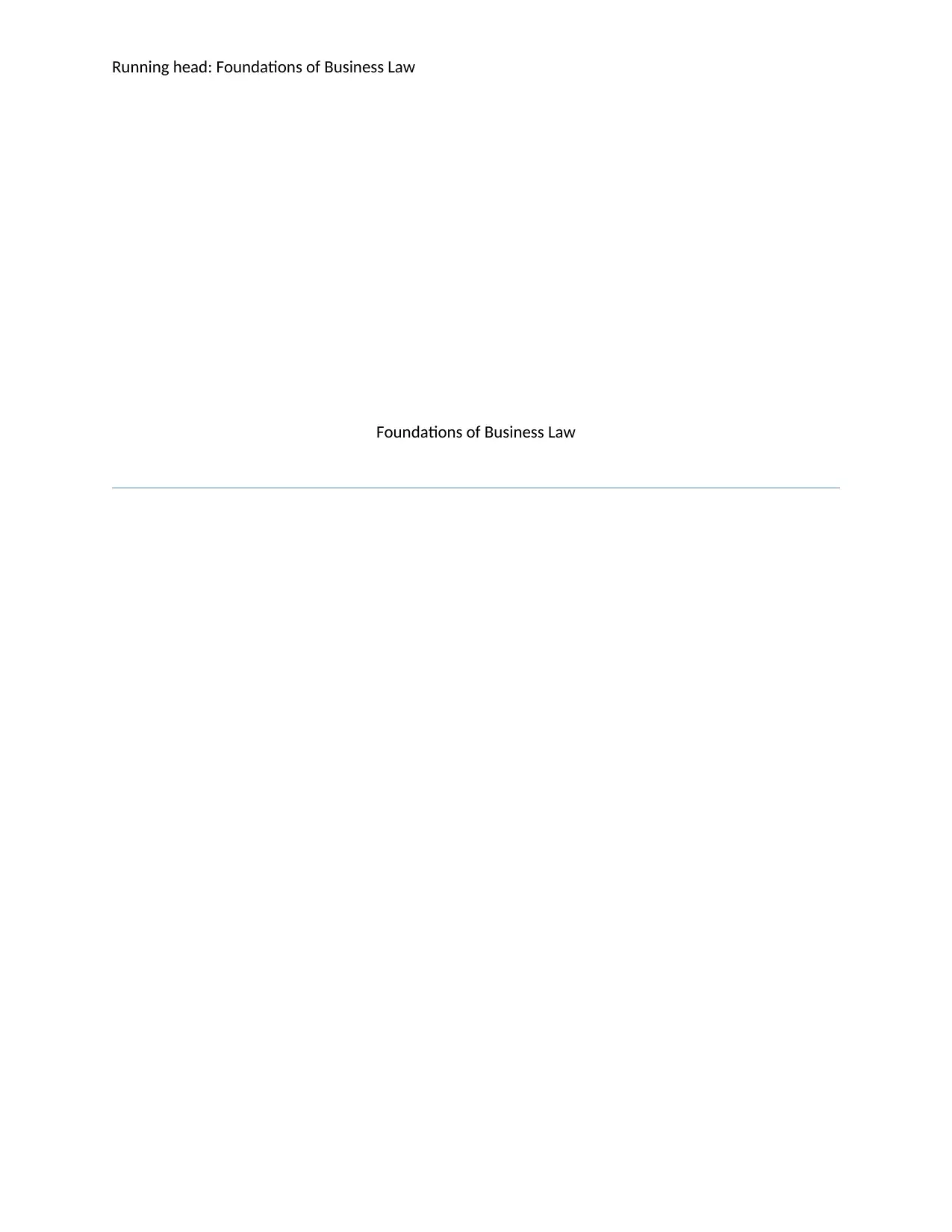
Running head: Foundations of Business Law
Foundations of Business Law
Foundations of Business Law
Paraphrase This Document
Need a fresh take? Get an instant paraphrase of this document with our AI Paraphraser
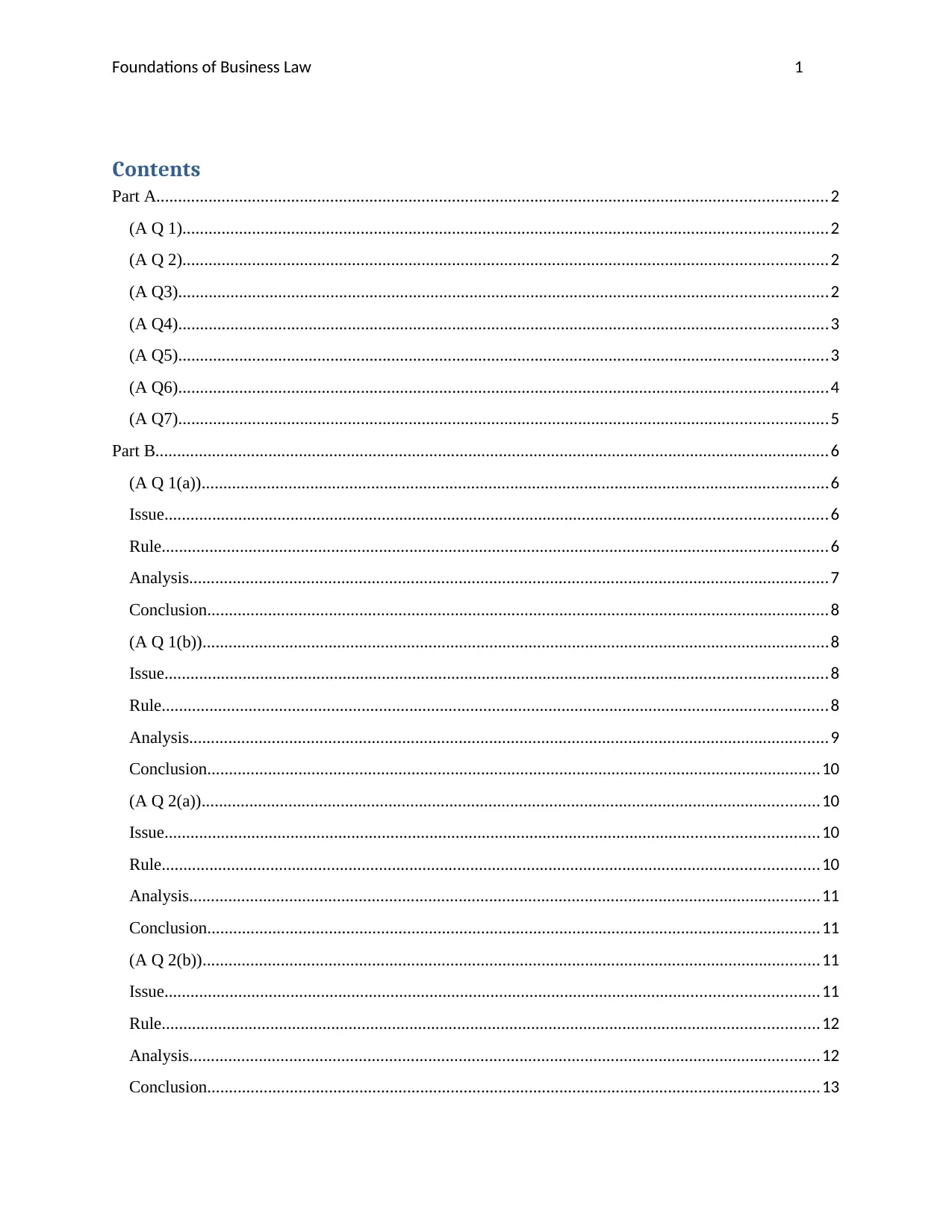
Foundations of Business Law 1
Contents
Part A..........................................................................................................................................................2
(A Q 1)....................................................................................................................................................2
(A Q 2)....................................................................................................................................................2
(A Q3).....................................................................................................................................................2
(A Q4).....................................................................................................................................................3
(A Q5).....................................................................................................................................................3
(A Q6).....................................................................................................................................................4
(A Q7).....................................................................................................................................................5
Part B...........................................................................................................................................................6
(A Q 1(a))................................................................................................................................................6
Issue........................................................................................................................................................6
Rule.........................................................................................................................................................6
Analysis...................................................................................................................................................7
Conclusion...............................................................................................................................................8
(A Q 1(b))................................................................................................................................................8
Issue........................................................................................................................................................8
Rule.........................................................................................................................................................8
Analysis...................................................................................................................................................9
Conclusion.............................................................................................................................................10
(A Q 2(a))..............................................................................................................................................10
Issue......................................................................................................................................................10
Rule.......................................................................................................................................................10
Analysis.................................................................................................................................................11
Conclusion.............................................................................................................................................11
(A Q 2(b))..............................................................................................................................................11
Issue......................................................................................................................................................11
Rule.......................................................................................................................................................12
Analysis.................................................................................................................................................12
Conclusion.............................................................................................................................................13
Contents
Part A..........................................................................................................................................................2
(A Q 1)....................................................................................................................................................2
(A Q 2)....................................................................................................................................................2
(A Q3).....................................................................................................................................................2
(A Q4).....................................................................................................................................................3
(A Q5).....................................................................................................................................................3
(A Q6).....................................................................................................................................................4
(A Q7).....................................................................................................................................................5
Part B...........................................................................................................................................................6
(A Q 1(a))................................................................................................................................................6
Issue........................................................................................................................................................6
Rule.........................................................................................................................................................6
Analysis...................................................................................................................................................7
Conclusion...............................................................................................................................................8
(A Q 1(b))................................................................................................................................................8
Issue........................................................................................................................................................8
Rule.........................................................................................................................................................8
Analysis...................................................................................................................................................9
Conclusion.............................................................................................................................................10
(A Q 2(a))..............................................................................................................................................10
Issue......................................................................................................................................................10
Rule.......................................................................................................................................................10
Analysis.................................................................................................................................................11
Conclusion.............................................................................................................................................11
(A Q 2(b))..............................................................................................................................................11
Issue......................................................................................................................................................11
Rule.......................................................................................................................................................12
Analysis.................................................................................................................................................12
Conclusion.............................................................................................................................................13
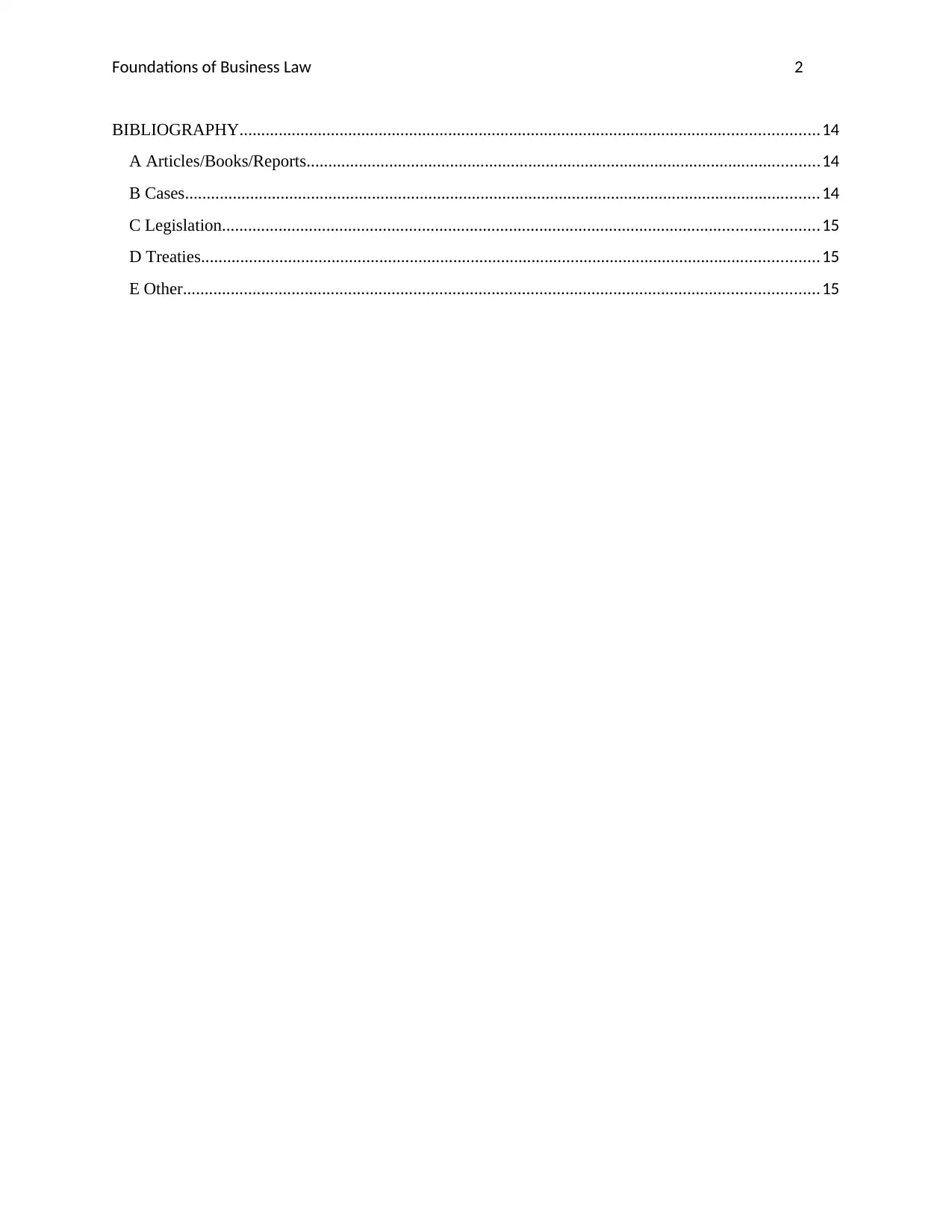
Foundations of Business Law 2
BIBLIOGRAPHY.....................................................................................................................................14
A Articles/Books/Reports......................................................................................................................14
B Cases..................................................................................................................................................14
C Legislation.........................................................................................................................................15
D Treaties..............................................................................................................................................15
E Other..................................................................................................................................................15
BIBLIOGRAPHY.....................................................................................................................................14
A Articles/Books/Reports......................................................................................................................14
B Cases..................................................................................................................................................14
C Legislation.........................................................................................................................................15
D Treaties..............................................................................................................................................15
E Other..................................................................................................................................................15
⊘ This is a preview!⊘
Do you want full access?
Subscribe today to unlock all pages.

Trusted by 1+ million students worldwide
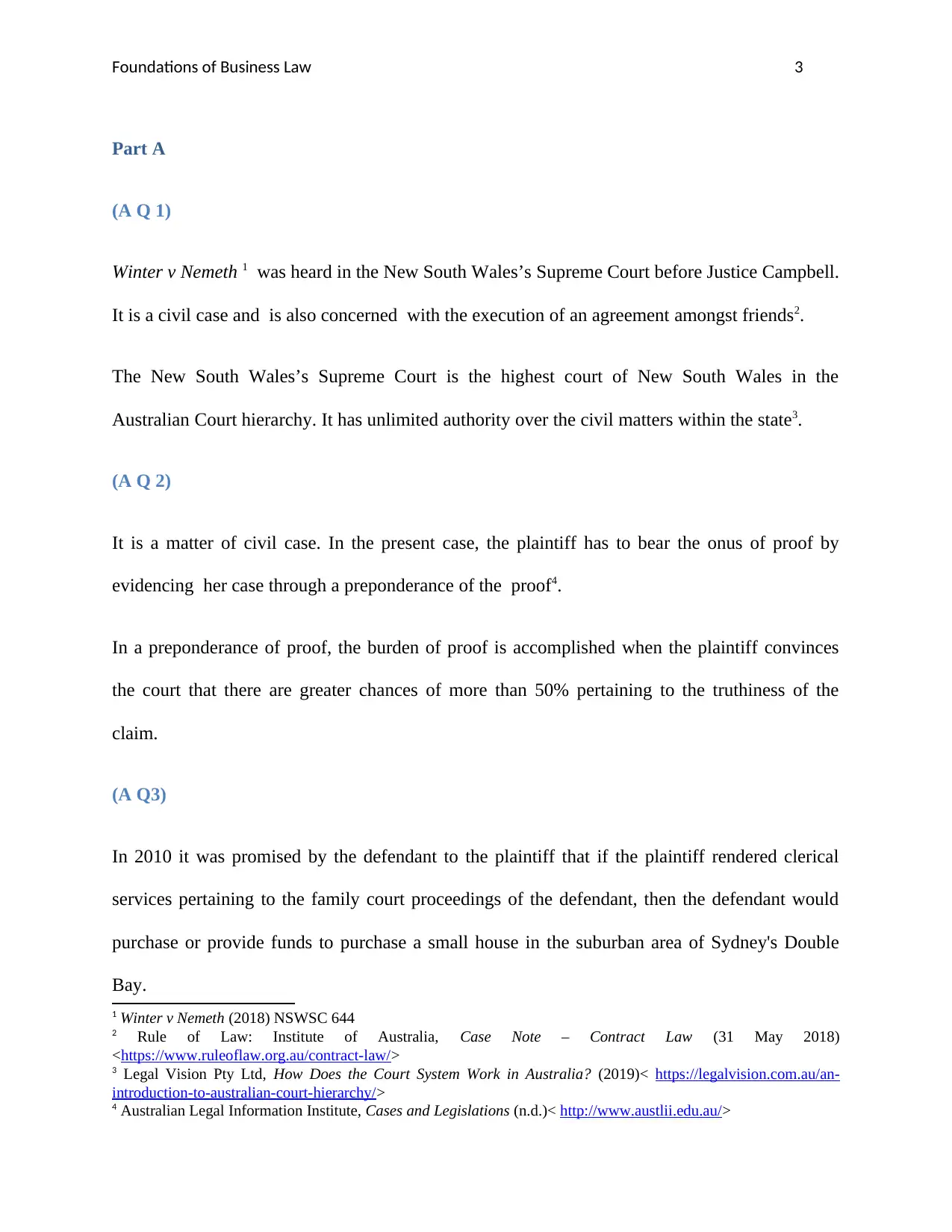
Foundations of Business Law 3
Part A
(A Q 1)
Winter v Nemeth 1 was heard in the New South Wales’s Supreme Court before Justice Campbell.
It is a civil case and is also concerned with the execution of an agreement amongst friends2.
The New South Wales’s Supreme Court is the highest court of New South Wales in the
Australian Court hierarchy. It has unlimited authority over the civil matters within the state3.
(A Q 2)
It is a matter of civil case. In the present case, the plaintiff has to bear the onus of proof by
evidencing her case through a preponderance of the proof4.
In a preponderance of proof, the burden of proof is accomplished when the plaintiff convinces
the court that there are greater chances of more than 50% pertaining to the truthiness of the
claim.
(A Q3)
In 2010 it was promised by the defendant to the plaintiff that if the plaintiff rendered clerical
services pertaining to the family court proceedings of the defendant, then the defendant would
purchase or provide funds to purchase a small house in the suburban area of Sydney's Double
Bay.
1 Winter v Nemeth (2018) NSWSC 644
2 Rule of Law: Institute of Australia, Case Note – Contract Law (31 May 2018)
<https://www.ruleoflaw.org.au/contract-law/>
3 Legal Vision Pty Ltd, How Does the Court System Work in Australia? (2019)< https://legalvision.com.au/an-
introduction-to-australian-court-hierarchy/>
4 Australian Legal Information Institute, Cases and Legislations (n.d.)< http://www.austlii.edu.au/>
Part A
(A Q 1)
Winter v Nemeth 1 was heard in the New South Wales’s Supreme Court before Justice Campbell.
It is a civil case and is also concerned with the execution of an agreement amongst friends2.
The New South Wales’s Supreme Court is the highest court of New South Wales in the
Australian Court hierarchy. It has unlimited authority over the civil matters within the state3.
(A Q 2)
It is a matter of civil case. In the present case, the plaintiff has to bear the onus of proof by
evidencing her case through a preponderance of the proof4.
In a preponderance of proof, the burden of proof is accomplished when the plaintiff convinces
the court that there are greater chances of more than 50% pertaining to the truthiness of the
claim.
(A Q3)
In 2010 it was promised by the defendant to the plaintiff that if the plaintiff rendered clerical
services pertaining to the family court proceedings of the defendant, then the defendant would
purchase or provide funds to purchase a small house in the suburban area of Sydney's Double
Bay.
1 Winter v Nemeth (2018) NSWSC 644
2 Rule of Law: Institute of Australia, Case Note – Contract Law (31 May 2018)
<https://www.ruleoflaw.org.au/contract-law/>
3 Legal Vision Pty Ltd, How Does the Court System Work in Australia? (2019)< https://legalvision.com.au/an-
introduction-to-australian-court-hierarchy/>
4 Australian Legal Information Institute, Cases and Legislations (n.d.)< http://www.austlii.edu.au/>
Paraphrase This Document
Need a fresh take? Get an instant paraphrase of this document with our AI Paraphraser
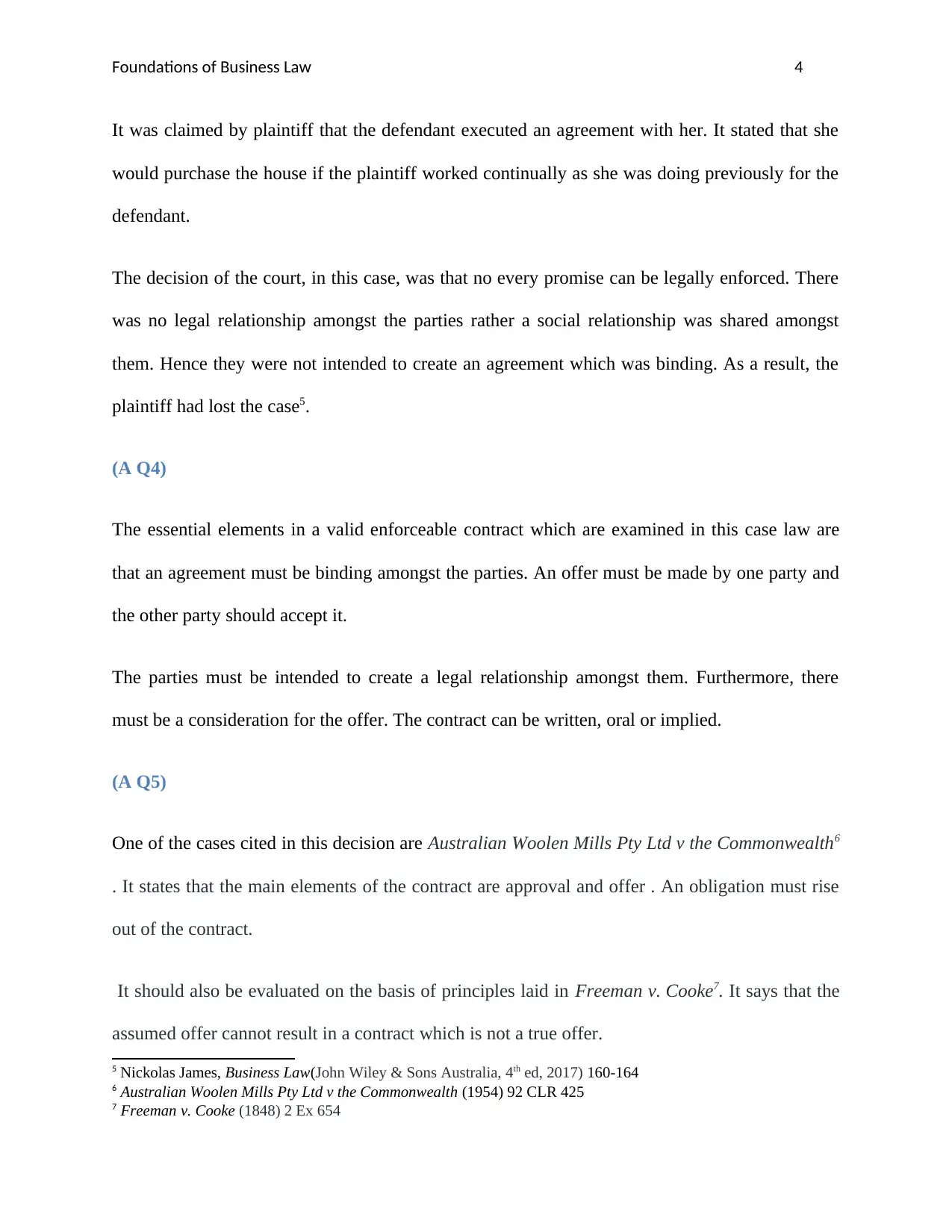
Foundations of Business Law 4
It was claimed by plaintiff that the defendant executed an agreement with her. It stated that she
would purchase the house if the plaintiff worked continually as she was doing previously for the
defendant.
The decision of the court, in this case, was that no every promise can be legally enforced. There
was no legal relationship amongst the parties rather a social relationship was shared amongst
them. Hence they were not intended to create an agreement which was binding. As a result, the
plaintiff had lost the case5.
(A Q4)
The essential elements in a valid enforceable contract which are examined in this case law are
that an agreement must be binding amongst the parties. An offer must be made by one party and
the other party should accept it.
The parties must be intended to create a legal relationship amongst them. Furthermore, there
must be a consideration for the offer. The contract can be written, oral or implied.
(A Q5)
One of the cases cited in this decision are Australian Woolen Mills Pty Ltd v the Commonwealth6
. It states that the main elements of the contract are approval and offer . An obligation must rise
out of the contract.
It should also be evaluated on the basis of principles laid in Freeman v. Cooke7. It says that the
assumed offer cannot result in a contract which is not a true offer.
5 Nickolas James, Business Law(John Wiley & Sons Australia, 4th ed, 2017) 160-164
6 Australian Woolen Mills Pty Ltd v the Commonwealth (1954) 92 CLR 425
7 Freeman v. Cooke (1848) 2 Ex 654
It was claimed by plaintiff that the defendant executed an agreement with her. It stated that she
would purchase the house if the plaintiff worked continually as she was doing previously for the
defendant.
The decision of the court, in this case, was that no every promise can be legally enforced. There
was no legal relationship amongst the parties rather a social relationship was shared amongst
them. Hence they were not intended to create an agreement which was binding. As a result, the
plaintiff had lost the case5.
(A Q4)
The essential elements in a valid enforceable contract which are examined in this case law are
that an agreement must be binding amongst the parties. An offer must be made by one party and
the other party should accept it.
The parties must be intended to create a legal relationship amongst them. Furthermore, there
must be a consideration for the offer. The contract can be written, oral or implied.
(A Q5)
One of the cases cited in this decision are Australian Woolen Mills Pty Ltd v the Commonwealth6
. It states that the main elements of the contract are approval and offer . An obligation must rise
out of the contract.
It should also be evaluated on the basis of principles laid in Freeman v. Cooke7. It says that the
assumed offer cannot result in a contract which is not a true offer.
5 Nickolas James, Business Law(John Wiley & Sons Australia, 4th ed, 2017) 160-164
6 Australian Woolen Mills Pty Ltd v the Commonwealth (1954) 92 CLR 425
7 Freeman v. Cooke (1848) 2 Ex 654
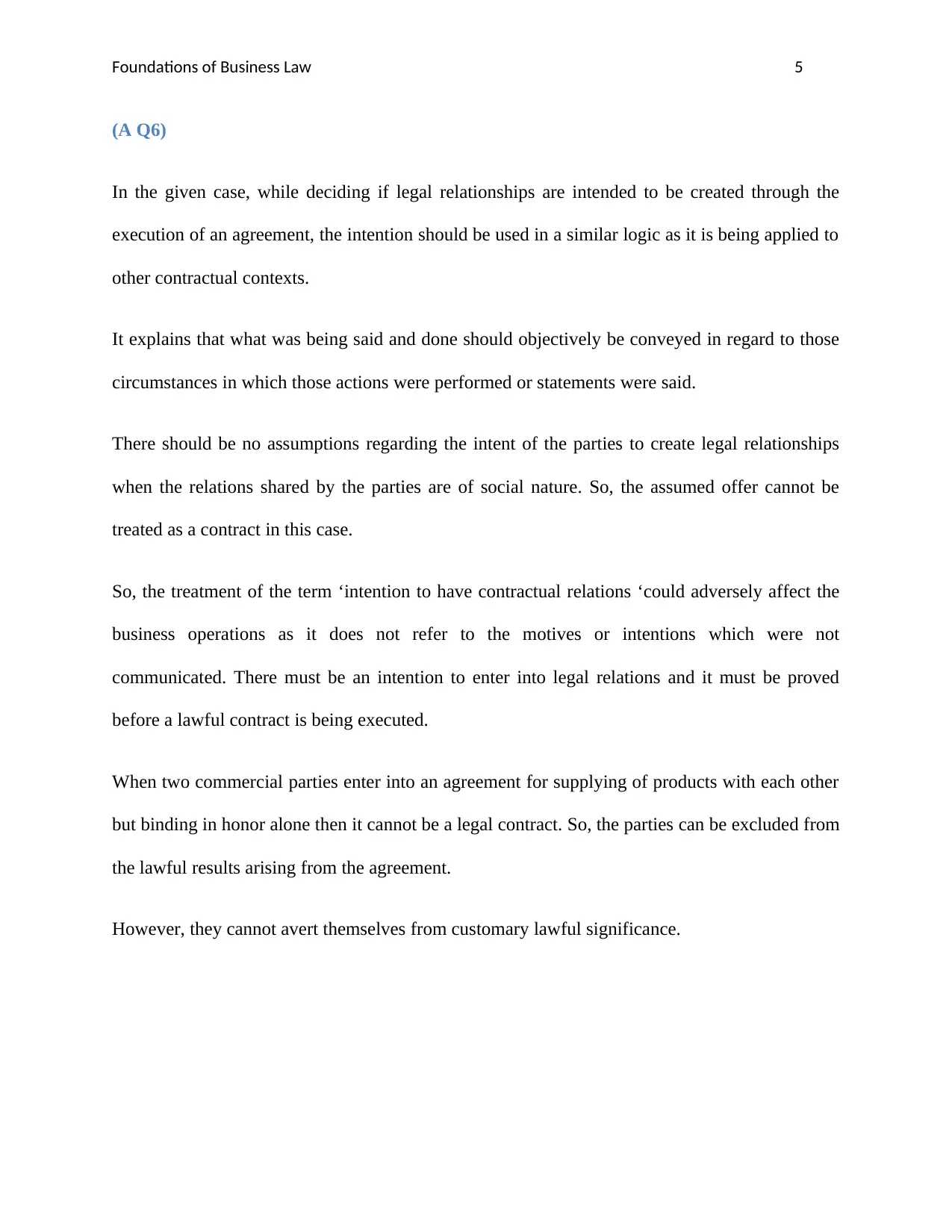
Foundations of Business Law 5
(A Q6)
In the given case, while deciding if legal relationships are intended to be created through the
execution of an agreement, the intention should be used in a similar logic as it is being applied to
other contractual contexts.
It explains that what was being said and done should objectively be conveyed in regard to those
circumstances in which those actions were performed or statements were said.
There should be no assumptions regarding the intent of the parties to create legal relationships
when the relations shared by the parties are of social nature. So, the assumed offer cannot be
treated as a contract in this case.
So, the treatment of the term ‘intention to have contractual relations ‘could adversely affect the
business operations as it does not refer to the motives or intentions which were not
communicated. There must be an intention to enter into legal relations and it must be proved
before a lawful contract is being executed.
When two commercial parties enter into an agreement for supplying of products with each other
but binding in honor alone then it cannot be a legal contract. So, the parties can be excluded from
the lawful results arising from the agreement.
However, they cannot avert themselves from customary lawful significance.
(A Q6)
In the given case, while deciding if legal relationships are intended to be created through the
execution of an agreement, the intention should be used in a similar logic as it is being applied to
other contractual contexts.
It explains that what was being said and done should objectively be conveyed in regard to those
circumstances in which those actions were performed or statements were said.
There should be no assumptions regarding the intent of the parties to create legal relationships
when the relations shared by the parties are of social nature. So, the assumed offer cannot be
treated as a contract in this case.
So, the treatment of the term ‘intention to have contractual relations ‘could adversely affect the
business operations as it does not refer to the motives or intentions which were not
communicated. There must be an intention to enter into legal relations and it must be proved
before a lawful contract is being executed.
When two commercial parties enter into an agreement for supplying of products with each other
but binding in honor alone then it cannot be a legal contract. So, the parties can be excluded from
the lawful results arising from the agreement.
However, they cannot avert themselves from customary lawful significance.
⊘ This is a preview!⊘
Do you want full access?
Subscribe today to unlock all pages.

Trusted by 1+ million students worldwide
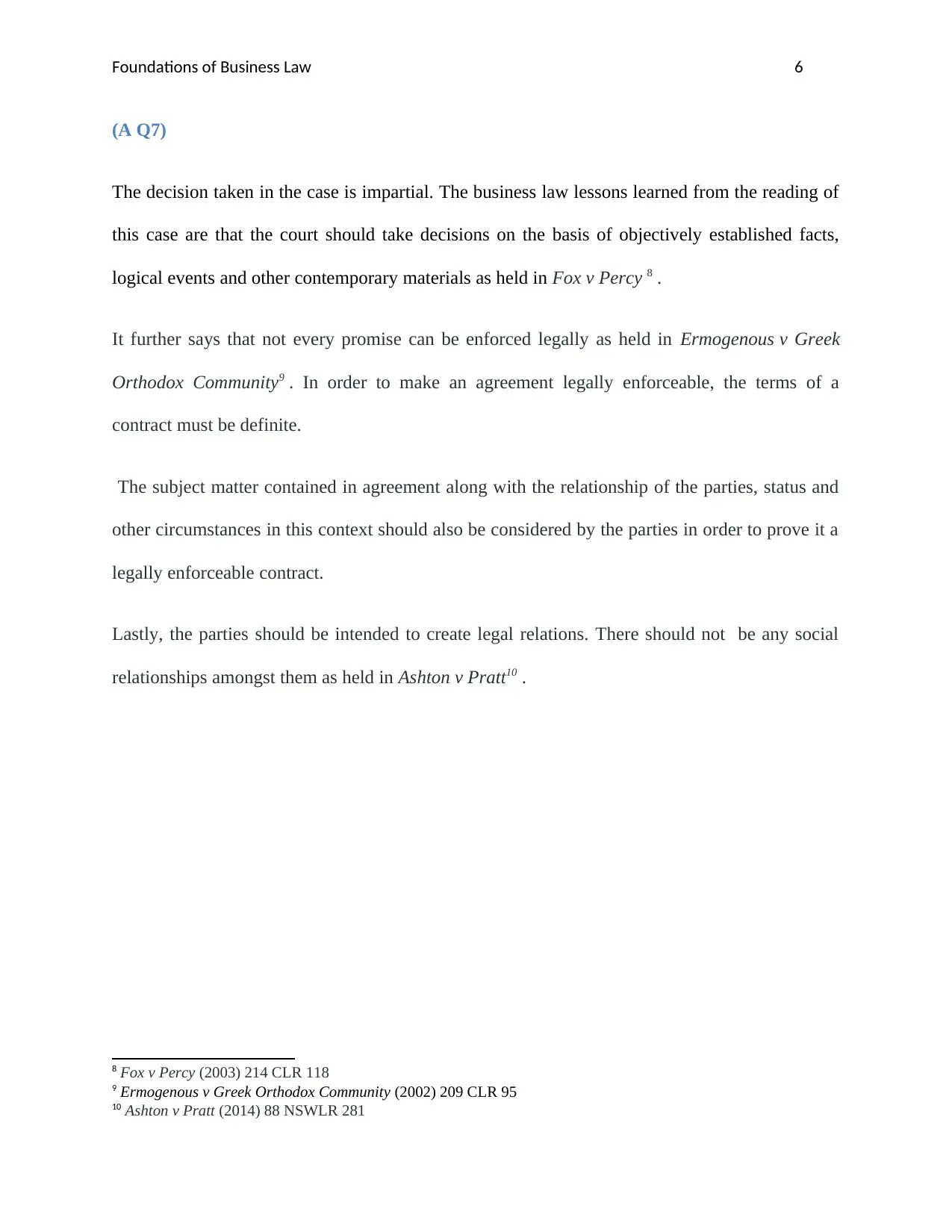
Foundations of Business Law 6
(A Q7)
The decision taken in the case is impartial. The business law lessons learned from the reading of
this case are that the court should take decisions on the basis of objectively established facts,
logical events and other contemporary materials as held in Fox v Percy 8 .
It further says that not every promise can be enforced legally as held in Ermogenous v Greek
Orthodox Community9 . In order to make an agreement legally enforceable, the terms of a
contract must be definite.
The subject matter contained in agreement along with the relationship of the parties, status and
other circumstances in this context should also be considered by the parties in order to prove it a
legally enforceable contract.
Lastly, the parties should be intended to create legal relations. There should not be any social
relationships amongst them as held in Ashton v Pratt10 .
8 Fox v Percy (2003) 214 CLR 118
9 Ermogenous v Greek Orthodox Community (2002) 209 CLR 95
10 Ashton v Pratt (2014) 88 NSWLR 281
(A Q7)
The decision taken in the case is impartial. The business law lessons learned from the reading of
this case are that the court should take decisions on the basis of objectively established facts,
logical events and other contemporary materials as held in Fox v Percy 8 .
It further says that not every promise can be enforced legally as held in Ermogenous v Greek
Orthodox Community9 . In order to make an agreement legally enforceable, the terms of a
contract must be definite.
The subject matter contained in agreement along with the relationship of the parties, status and
other circumstances in this context should also be considered by the parties in order to prove it a
legally enforceable contract.
Lastly, the parties should be intended to create legal relations. There should not be any social
relationships amongst them as held in Ashton v Pratt10 .
8 Fox v Percy (2003) 214 CLR 118
9 Ermogenous v Greek Orthodox Community (2002) 209 CLR 95
10 Ashton v Pratt (2014) 88 NSWLR 281
Paraphrase This Document
Need a fresh take? Get an instant paraphrase of this document with our AI Paraphraser
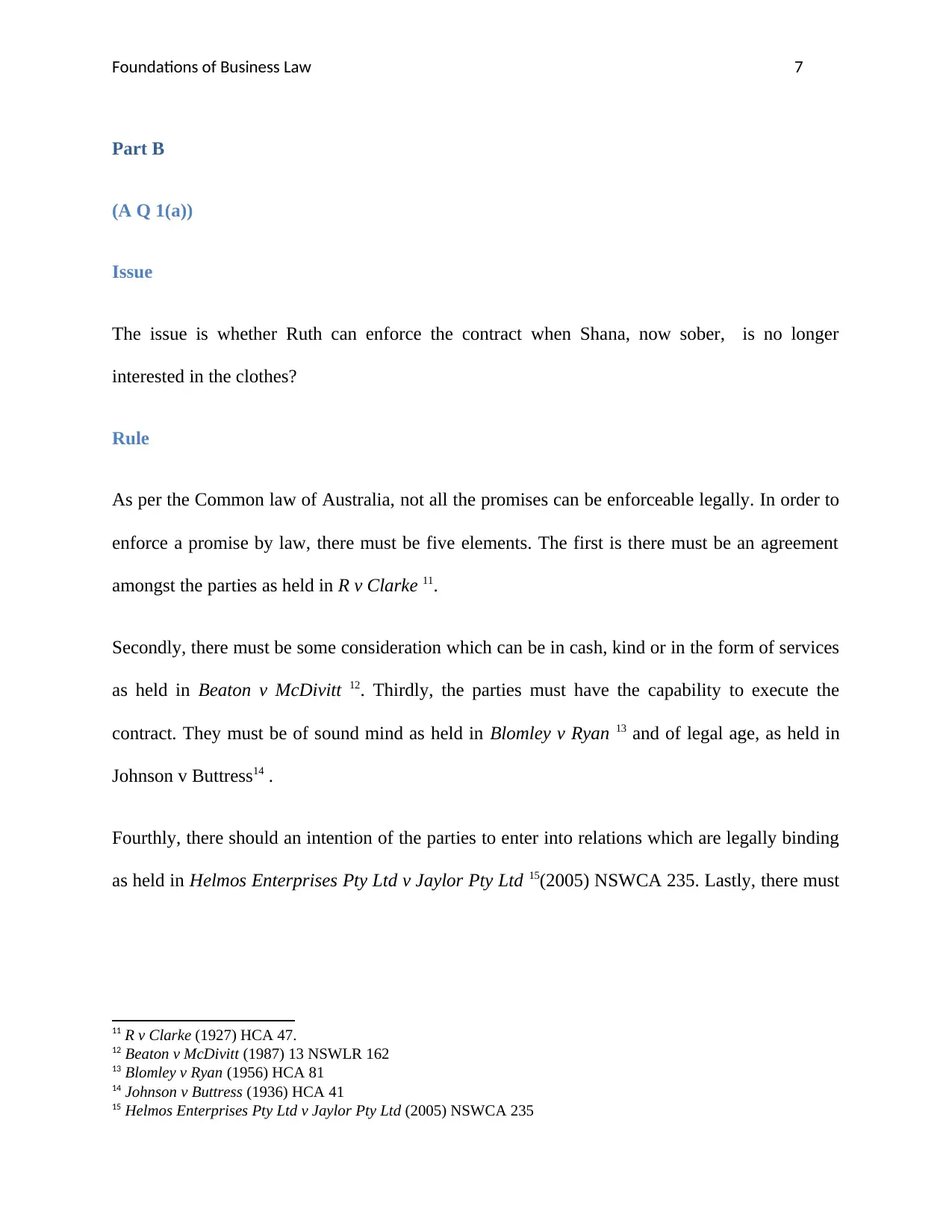
Foundations of Business Law 7
Part B
(A Q 1(a))
Issue
The issue is whether Ruth can enforce the contract when Shana, now sober, is no longer
interested in the clothes?
Rule
As per the Common law of Australia, not all the promises can be enforceable legally. In order to
enforce a promise by law, there must be five elements. The first is there must be an agreement
amongst the parties as held in R v Clarke 11.
Secondly, there must be some consideration which can be in cash, kind or in the form of services
as held in Beaton v McDivitt 12. Thirdly, the parties must have the capability to execute the
contract. They must be of sound mind as held in Blomley v Ryan 13 and of legal age, as held in
Johnson v Buttress14 .
Fourthly, there should an intention of the parties to enter into relations which are legally binding
as held in Helmos Enterprises Pty Ltd v Jaylor Pty Ltd 15(2005) NSWCA 235. Lastly, there must
11 R v Clarke (1927) HCA 47.
12 Beaton v McDivitt (1987) 13 NSWLR 162
13 Blomley v Ryan (1956) HCA 81
14 Johnson v Buttress (1936) HCA 41
15 Helmos Enterprises Pty Ltd v Jaylor Pty Ltd (2005) NSWCA 235
Part B
(A Q 1(a))
Issue
The issue is whether Ruth can enforce the contract when Shana, now sober, is no longer
interested in the clothes?
Rule
As per the Common law of Australia, not all the promises can be enforceable legally. In order to
enforce a promise by law, there must be five elements. The first is there must be an agreement
amongst the parties as held in R v Clarke 11.
Secondly, there must be some consideration which can be in cash, kind or in the form of services
as held in Beaton v McDivitt 12. Thirdly, the parties must have the capability to execute the
contract. They must be of sound mind as held in Blomley v Ryan 13 and of legal age, as held in
Johnson v Buttress14 .
Fourthly, there should an intention of the parties to enter into relations which are legally binding
as held in Helmos Enterprises Pty Ltd v Jaylor Pty Ltd 15(2005) NSWCA 235. Lastly, there must
11 R v Clarke (1927) HCA 47.
12 Beaton v McDivitt (1987) 13 NSWLR 162
13 Blomley v Ryan (1956) HCA 81
14 Johnson v Buttress (1936) HCA 41
15 Helmos Enterprises Pty Ltd v Jaylor Pty Ltd (2005) NSWCA 235
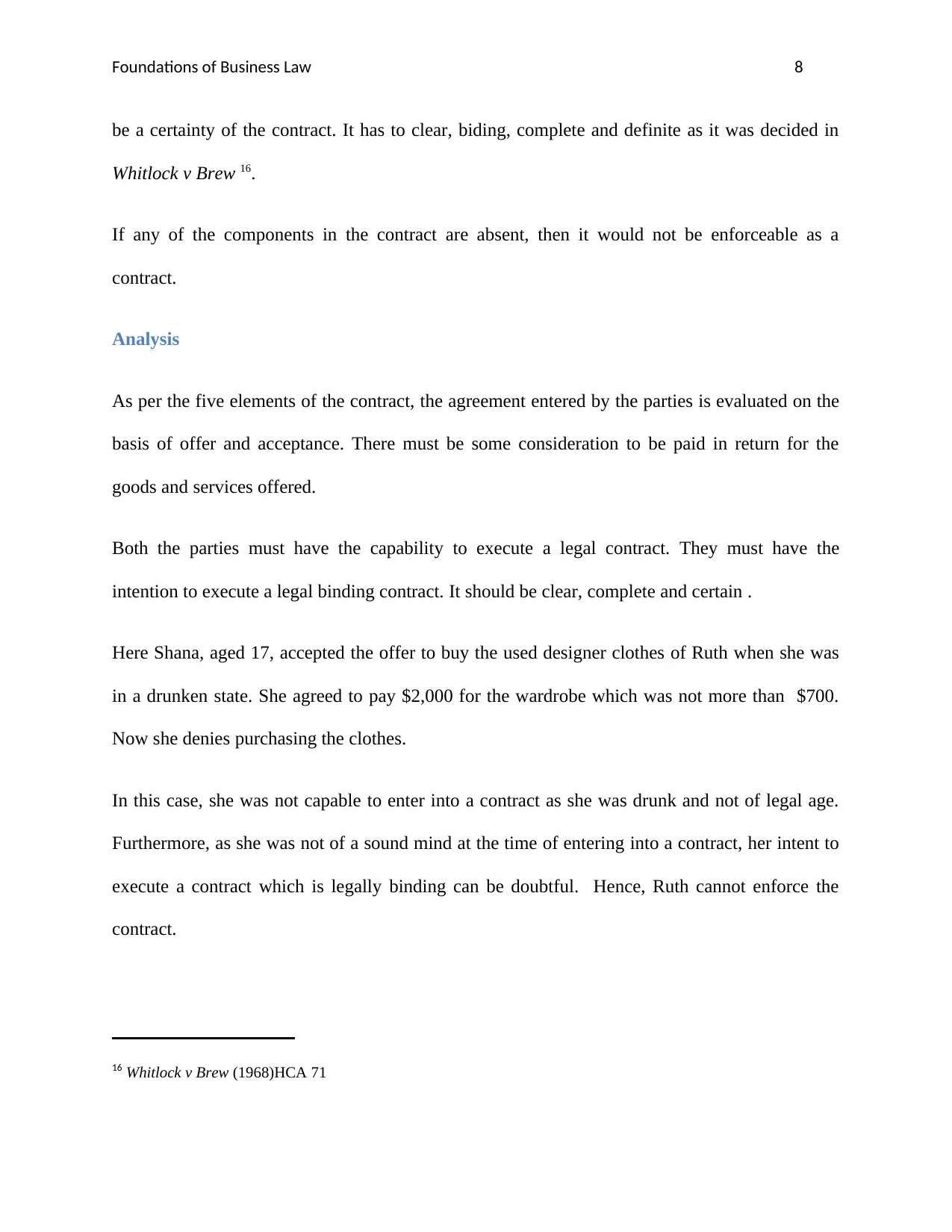
Foundations of Business Law 8
be a certainty of the contract. It has to clear, biding, complete and definite as it was decided in
Whitlock v Brew 16.
If any of the components in the contract are absent, then it would not be enforceable as a
contract.
Analysis
As per the five elements of the contract, the agreement entered by the parties is evaluated on the
basis of offer and acceptance. There must be some consideration to be paid in return for the
goods and services offered.
Both the parties must have the capability to execute a legal contract. They must have the
intention to execute a legal binding contract. It should be clear, complete and certain .
Here Shana, aged 17, accepted the offer to buy the used designer clothes of Ruth when she was
in a drunken state. She agreed to pay $2,000 for the wardrobe which was not more than $700.
Now she denies purchasing the clothes.
In this case, she was not capable to enter into a contract as she was drunk and not of legal age.
Furthermore, as she was not of a sound mind at the time of entering into a contract, her intent to
execute a contract which is legally binding can be doubtful. Hence, Ruth cannot enforce the
contract.
16 Whitlock v Brew (1968)HCA 71
be a certainty of the contract. It has to clear, biding, complete and definite as it was decided in
Whitlock v Brew 16.
If any of the components in the contract are absent, then it would not be enforceable as a
contract.
Analysis
As per the five elements of the contract, the agreement entered by the parties is evaluated on the
basis of offer and acceptance. There must be some consideration to be paid in return for the
goods and services offered.
Both the parties must have the capability to execute a legal contract. They must have the
intention to execute a legal binding contract. It should be clear, complete and certain .
Here Shana, aged 17, accepted the offer to buy the used designer clothes of Ruth when she was
in a drunken state. She agreed to pay $2,000 for the wardrobe which was not more than $700.
Now she denies purchasing the clothes.
In this case, she was not capable to enter into a contract as she was drunk and not of legal age.
Furthermore, as she was not of a sound mind at the time of entering into a contract, her intent to
execute a contract which is legally binding can be doubtful. Hence, Ruth cannot enforce the
contract.
16 Whitlock v Brew (1968)HCA 71
⊘ This is a preview!⊘
Do you want full access?
Subscribe today to unlock all pages.

Trusted by 1+ million students worldwide
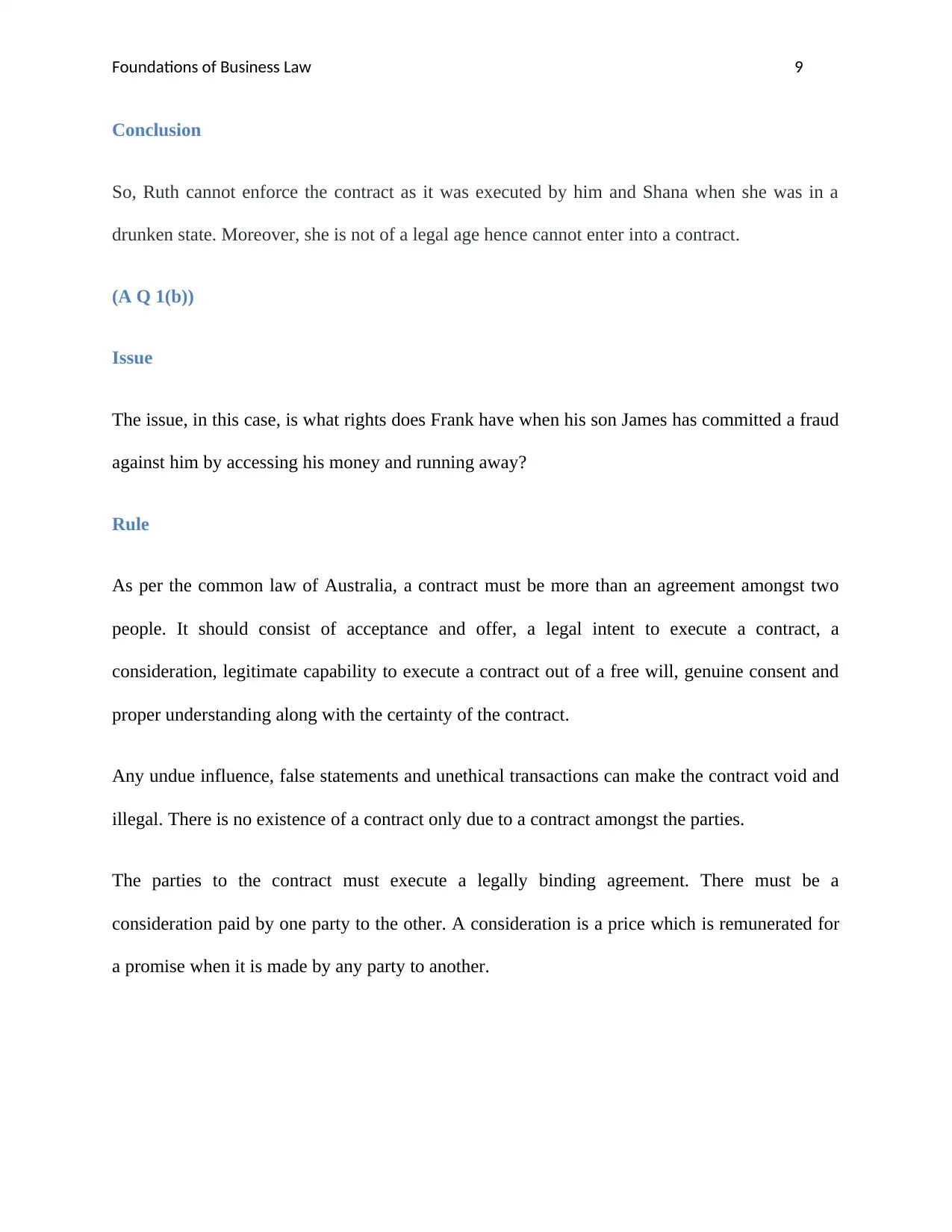
Foundations of Business Law 9
Conclusion
So, Ruth cannot enforce the contract as it was executed by him and Shana when she was in a
drunken state. Moreover, she is not of a legal age hence cannot enter into a contract.
(A Q 1(b))
Issue
The issue, in this case, is what rights does Frank have when his son James has committed a fraud
against him by accessing his money and running away?
Rule
As per the common law of Australia, a contract must be more than an agreement amongst two
people. It should consist of acceptance and offer, a legal intent to execute a contract, a
consideration, legitimate capability to execute a contract out of a free will, genuine consent and
proper understanding along with the certainty of the contract.
Any undue influence, false statements and unethical transactions can make the contract void and
illegal. There is no existence of a contract only due to a contract amongst the parties.
The parties to the contract must execute a legally binding agreement. There must be a
consideration paid by one party to the other. A consideration is a price which is remunerated for
a promise when it is made by any party to another.
Conclusion
So, Ruth cannot enforce the contract as it was executed by him and Shana when she was in a
drunken state. Moreover, she is not of a legal age hence cannot enter into a contract.
(A Q 1(b))
Issue
The issue, in this case, is what rights does Frank have when his son James has committed a fraud
against him by accessing his money and running away?
Rule
As per the common law of Australia, a contract must be more than an agreement amongst two
people. It should consist of acceptance and offer, a legal intent to execute a contract, a
consideration, legitimate capability to execute a contract out of a free will, genuine consent and
proper understanding along with the certainty of the contract.
Any undue influence, false statements and unethical transactions can make the contract void and
illegal. There is no existence of a contract only due to a contract amongst the parties.
The parties to the contract must execute a legally binding agreement. There must be a
consideration paid by one party to the other. A consideration is a price which is remunerated for
a promise when it is made by any party to another.
Paraphrase This Document
Need a fresh take? Get an instant paraphrase of this document with our AI Paraphraser
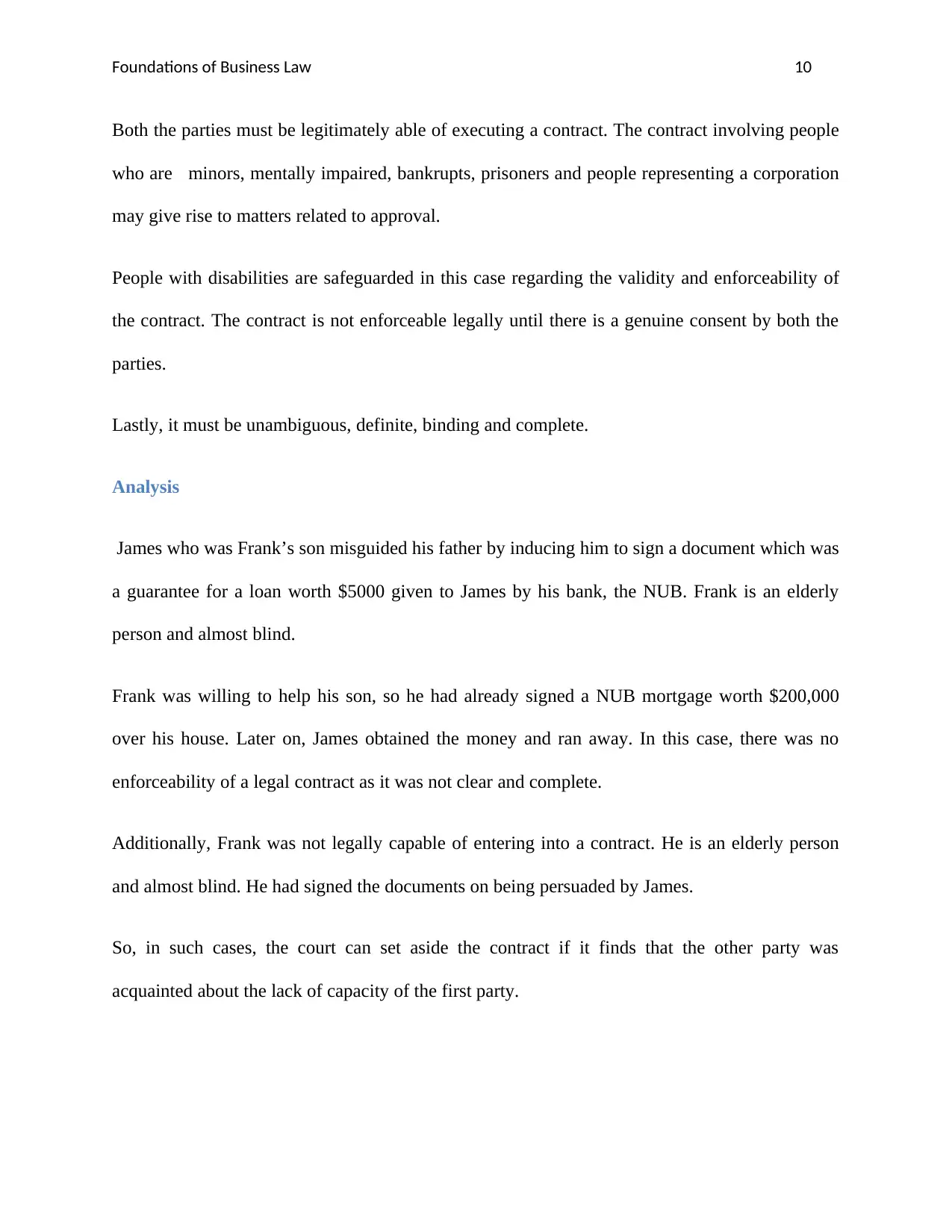
Foundations of Business Law 10
Both the parties must be legitimately able of executing a contract. The contract involving people
who are minors, mentally impaired, bankrupts, prisoners and people representing a corporation
may give rise to matters related to approval.
People with disabilities are safeguarded in this case regarding the validity and enforceability of
the contract. The contract is not enforceable legally until there is a genuine consent by both the
parties.
Lastly, it must be unambiguous, definite, binding and complete.
Analysis
James who was Frank’s son misguided his father by inducing him to sign a document which was
a guarantee for a loan worth $5000 given to James by his bank, the NUB. Frank is an elderly
person and almost blind.
Frank was willing to help his son, so he had already signed a NUB mortgage worth $200,000
over his house. Later on, James obtained the money and ran away. In this case, there was no
enforceability of a legal contract as it was not clear and complete.
Additionally, Frank was not legally capable of entering into a contract. He is an elderly person
and almost blind. He had signed the documents on being persuaded by James.
So, in such cases, the court can set aside the contract if it finds that the other party was
acquainted about the lack of capacity of the first party.
Both the parties must be legitimately able of executing a contract. The contract involving people
who are minors, mentally impaired, bankrupts, prisoners and people representing a corporation
may give rise to matters related to approval.
People with disabilities are safeguarded in this case regarding the validity and enforceability of
the contract. The contract is not enforceable legally until there is a genuine consent by both the
parties.
Lastly, it must be unambiguous, definite, binding and complete.
Analysis
James who was Frank’s son misguided his father by inducing him to sign a document which was
a guarantee for a loan worth $5000 given to James by his bank, the NUB. Frank is an elderly
person and almost blind.
Frank was willing to help his son, so he had already signed a NUB mortgage worth $200,000
over his house. Later on, James obtained the money and ran away. In this case, there was no
enforceability of a legal contract as it was not clear and complete.
Additionally, Frank was not legally capable of entering into a contract. He is an elderly person
and almost blind. He had signed the documents on being persuaded by James.
So, in such cases, the court can set aside the contract if it finds that the other party was
acquainted about the lack of capacity of the first party.
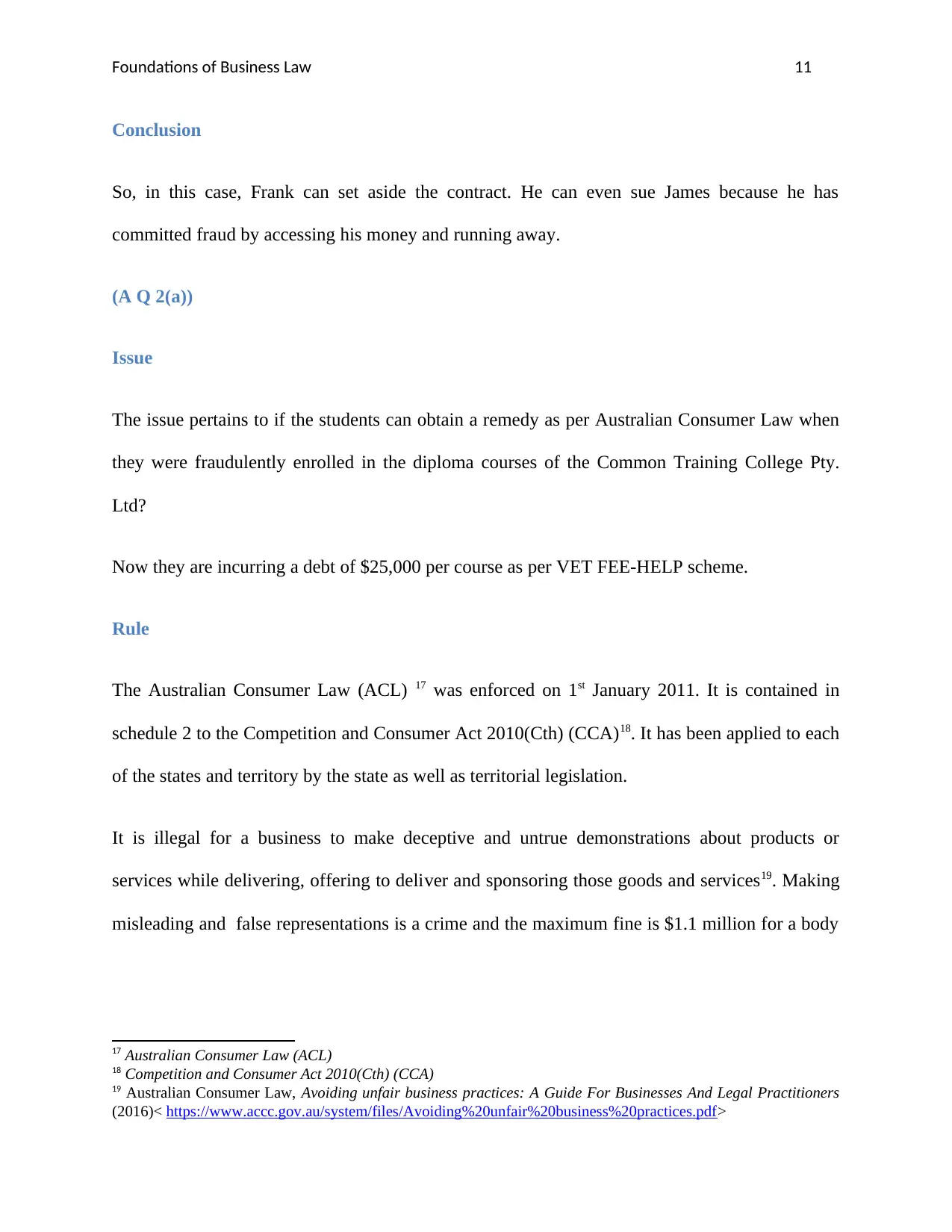
Foundations of Business Law 11
Conclusion
So, in this case, Frank can set aside the contract. He can even sue James because he has
committed fraud by accessing his money and running away.
(A Q 2(a))
Issue
The issue pertains to if the students can obtain a remedy as per Australian Consumer Law when
they were fraudulently enrolled in the diploma courses of the Common Training College Pty.
Ltd?
Now they are incurring a debt of $25,000 per course as per VET FEE-HELP scheme.
Rule
The Australian Consumer Law (ACL) 17 was enforced on 1st January 2011. It is contained in
schedule 2 to the Competition and Consumer Act 2010(Cth) (CCA)18. It has been applied to each
of the states and territory by the state as well as territorial legislation.
It is illegal for a business to make deceptive and untrue demonstrations about products or
services while delivering, offering to deliver and sponsoring those goods and services19. Making
misleading and false representations is a crime and the maximum fine is $1.1 million for a body
17 Australian Consumer Law (ACL)
18 Competition and Consumer Act 2010(Cth) (CCA)
19 Australian Consumer Law, Avoiding unfair business practices: A Guide For Businesses And Legal Practitioners
(2016)< https://www.accc.gov.au/system/files/Avoiding%20unfair%20business%20practices.pdf>
Conclusion
So, in this case, Frank can set aside the contract. He can even sue James because he has
committed fraud by accessing his money and running away.
(A Q 2(a))
Issue
The issue pertains to if the students can obtain a remedy as per Australian Consumer Law when
they were fraudulently enrolled in the diploma courses of the Common Training College Pty.
Ltd?
Now they are incurring a debt of $25,000 per course as per VET FEE-HELP scheme.
Rule
The Australian Consumer Law (ACL) 17 was enforced on 1st January 2011. It is contained in
schedule 2 to the Competition and Consumer Act 2010(Cth) (CCA)18. It has been applied to each
of the states and territory by the state as well as territorial legislation.
It is illegal for a business to make deceptive and untrue demonstrations about products or
services while delivering, offering to deliver and sponsoring those goods and services19. Making
misleading and false representations is a crime and the maximum fine is $1.1 million for a body
17 Australian Consumer Law (ACL)
18 Competition and Consumer Act 2010(Cth) (CCA)
19 Australian Consumer Law, Avoiding unfair business practices: A Guide For Businesses And Legal Practitioners
(2016)< https://www.accc.gov.au/system/files/Avoiding%20unfair%20business%20practices.pdf>
⊘ This is a preview!⊘
Do you want full access?
Subscribe today to unlock all pages.

Trusted by 1+ million students worldwide
1 out of 17
Related Documents
Your All-in-One AI-Powered Toolkit for Academic Success.
+13062052269
info@desklib.com
Available 24*7 on WhatsApp / Email
![[object Object]](/_next/static/media/star-bottom.7253800d.svg)
Unlock your academic potential
Copyright © 2020–2025 A2Z Services. All Rights Reserved. Developed and managed by ZUCOL.





